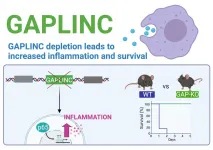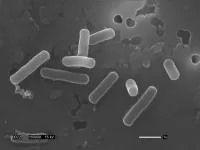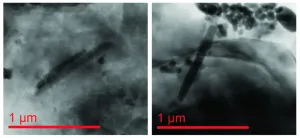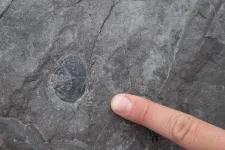INFORMATION:
https://jamanetwork.com/journals/jamapediatrics/fullarticle/2775874
Halved risk for severe retinal disease in extremely premature infants
2021-02-01
(Press-News.org) Risk for a severe form of retinopathy of prematurity, which can cause blindness in extremely premature babies, was halved when the newborns were given a new supplement combining various fatty acids. This was shown in a Swedish study led from the University of Gothenburg.
The study, now published in JAMA Pediatrics, is described as groundbreaking in its field. It documents a clear fall in retinopathy of prematurity (ROP) among extremely premature (EP) infants (born before 28 weeks' gestation), whose retinal blood vessels are not fully developed. The condition can cause visual impairment and, at worst, blindness after retinal detachment.
The study included 206 EP babies in the neonatal wards at the university hospitals in Gothenburg, Lund, and Stockholm over a period exceeding three years, 2016-19.
Roughly half of these newborns were given prophylactic nutritional supplements, orally, with the omega-3 fatty acid DHA (50 milligrams per day and kilogram of body weight), combined with the omega-6 fatty acid arachidonic acid (twice as much). Today, the latter fatty acid is not included in the supplements routinely administered to EP babies immediately after birth.
In the group of EP infants given the fatty acid supplement, 16 of 101 (15.8 percent) had severe ROP. The corresponding proportion in the control group was 35 of 105 (33.3 percent).
In adults, high levels of omega-6 fatty acids are associated with inflammation and cardiovascular disease. In the fetal period, arachidonic acid is an essential building block for cellmembranes and act as signaling molecules between cells. The omega-3 fatty acid DHA is a vital component for blood vessels and nerve tissue.
Ann Hellström, Professor of Pediatric Ophthalmology at Sahlgrenska Academy, University of Gothenburg, and chief physician at Sahlgrenska University Hospital, is in charge of the study.
In previous studies, the research group have shown the connection between ROP and low arachidonic acid levels in EP babies' blood. Administering arachidonic acid as a supplement has been a topic of debate, and further clinical studies on how to devise an optimal mix of fatty acids have been called for.
"In our study, we're taking a step toward answering that question by showing such a distinct reduction in one of the severe neurovascular complications that can arise after extremely preterm birth" Hellström says.
Other results in the study showed no significant differences between the two groups in terms of the incidence of the lung disease bronchopulmonary dysplasia, or in the degree of intraventricular cerebral hemorrhage, which is also common in EP infants. Sepsis occurred in slightly fewer of those who received the fatty acid supplement: 42 of 101 babies, against 53 of 105 in the control group.
Every year, approximately a thousand EP babies in Sweden are screened for ROP. Four of ten born before 30 weeks' gestation suffer from the disease to some degree. In Sweden, blindness can usually be prevented with laser treatment. Worldwide, however, some 20,000 infants go blind or suffer from severe visual impairment annually as a result of ROP.
ELSE PRESS RELEASES FROM THIS DATE:
Study identifies noncoding RNA involved in immune response and sepsis
2021-02-01
When the body's immune response to an infection gets out of control, the result can be sepsis, a life-threatening condition in which an overwhelming inflammatory response can lead rapidly to failure of multiple organs and death.
In a new study, researchers at UC Santa Cruz have identified a long noncoding RNA (lncRNA) molecule that regulates the expression of pro-inflammatory genes in immune system cells called macrophages and affects the susceptibility of mice to septic shock.
This lncRNA, called GAPLINC, was previously studied for its role in cancer, but it turns out to be the most highly expressed lncRNA in macrophages, which play a central role in inflammation. ...
Newly discovered trait helps plants grow deeper roots in dry, compacted soils
2021-02-01
A previously unknown root trait allows some cereal plants to grow deeper roots capable of punching through dry, hard, compacted soils, according to Penn State researchers, who suggest that harnessing the inherited characteristic could lead to crops better able to deal with a changing climate.
"This discovery bodes well for American and global agriculture because the trait helps corn, wheat and barley grow deeper roots, which is important for drought tolerance, nitrogen efficiency and carbon sequestration," said Jonathan Lynch, distinguished professor in plant science. "Breeding for this trait should be helpful in developing new crops for climate mitigation."
Called multiseriate cortical sclerenchyma by the researchers -- or MCS -- the phenotype is ...
Lactobacillus manipulates bile acids to create favorable gut environment
2021-02-01
New research from North Carolina State University reveals that probiotic Lactobacillus bacteria use enzymes situationally to manipulate bile acids and promote their own survival in the gut. These findings further elucidate the complicated relationship between bile acids and gut bacteria and could eventually enable researchers to design lactobacilli with therapeutic properties, thereby engineering a healthier human gut environment.
Bile acids are key players in digestion and overall gut health. Produced in the liver and released after we eat, these acids not ...
Marine organisms use previously undiscovered receptors to detect, respond to light
2021-02-01
Just as plants and animals on land are keenly attuned to the hours of sunlight in the day, life in the oceans follows the rhythms of the day, the seasons and even the moon. A University of Washington study finds the biological light switches that make this possible.
Single-celled organisms in the open ocean use a diverse array of genetic tools to detect light, even in tiny amounts, and respond, according to a study published Feb. 1 in the Proceedings of the National Academy of Sciences.
"If you look in the ocean environment, all these different organisms have this day-night cycle. They are very in tune with each other, even as they get moved around. How do they know when it's day? How do they know when it's night?" said lead ...
Mysterious magnetic fossils offer past climate clues
2021-02-01
There are fossils, found in ancient marine sediments and made up of no more than a few magnetic nanoparticles, that can tell us a whole lot about the climate of the past, especially episodes of abrupt global warming. Now, researchers including doctoral student Courtney Wagner and associate professor Peter Lippert from the University of Utah, have found a way to glean the valuable information in those fossils without having to crush the scarce samples into a fine powder. Their results are published in Proceedings of the National Academy of Sciences.
"It's so fun to be a part of a discovery like this, something that can be used ...
Physics of snakeskin sheds light on sidewinding
2021-02-01
Most snakes get from A to B by bending their bodies into S-shapes and slithering forward headfirst. A few species, however -- found in the deserts of North America, Africa and the Middle East -- have an odder way of getting around. Known as "sidewinders," these snakes lead with their mid-sections instead of their heads, slinking sideways across loose sand.
Scientists took a microscopic look at the skin of sidewinders to see if it plays a role in their unique method of movement. They discovered that sidewinders' bellies are studded with tiny pits and have few, if any, of the tiny spikes found on the bellies of other snakes.
The Proceedings ...
Geologists produce new timeline of Earth's Paleozoic climate changes
2021-02-01
CAMBRIDGE -- The temperature of a planet is linked with the diversity of life that it can support. MIT geologists have now reconstructed a timeline of the Earth's temperature during the early Paleozoic era, between 510 and 440 million years ago -- a pivotal period when animals became abundant in a previously microbe-dominated world.
In a study appearing today in the Proceedings of the National Academy of Sciences, the researchers chart dips and peaks in the global temperature during the early Paleozoic. They report that these temperature variations coincide with the planet's ...
Researchers discover mechanism to overcome drug-resistance in leukemia
2021-02-01
In a new study led by Yale Cancer Center, researchers have discovered a novel metabolic gatekeeper mechanism for leukemia. This mechanism depends on a molecule called PON2, which could lead to a new treatment for the disease. The findings were published online today in the Proceedings of the National Academy of Sciences (PNAS).
B cells are effector cells of the adaptive immune system and are marked by low energy levels, which prevent transformation to leukemia. In this study, Yale scientists identified high expression levels of the detoxifying lactonase ...
Researchers demonstrate how defects in mitochondria may lead to autism spectrum disorder
2021-02-01
Philadelphia, February 1, 2021 - Researchers at Children's Hospital of Philadelphia (CHOP) have demonstrated that autism spectrum disorder (ASD) may be caused by defects in the mitochondria of brain cells. The findings were published online by the Proceedings of the National Academy of Sciences.
Multiple studies have revealed hundreds of mutations associated with autism spectrum disorder, but there is no consensus as to how these genetic changes cause the condition. Biochemical and physiological analyses have suggested that deficiencies in mitochondria, the "batteries" of the cell that produce ...
Common HIV drugs may prevent leading cause of vision loss, study finds
2021-02-01
Scientists have identified a group of drugs that may help stop a leading cause of vision loss after making an unexpected discovery that overturns a fundamental belief about DNA.
The drugs, known as Nucleoside Reverse Transcriptase Inhibitors, or NRTIs, are commonly used to treat HIV. The new discovery suggests that they may be useful against dry macular degeneration as well, even though a virus does not cause that sight-stealing condition.
A review of four different health insurance databases suggests that people taking these drugs have significantly reduced risk of developing dry macular degeneration, a condition that affects ...









